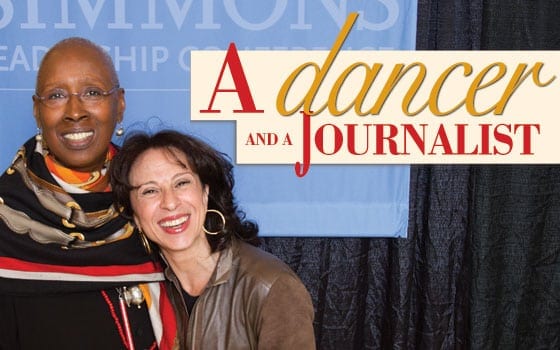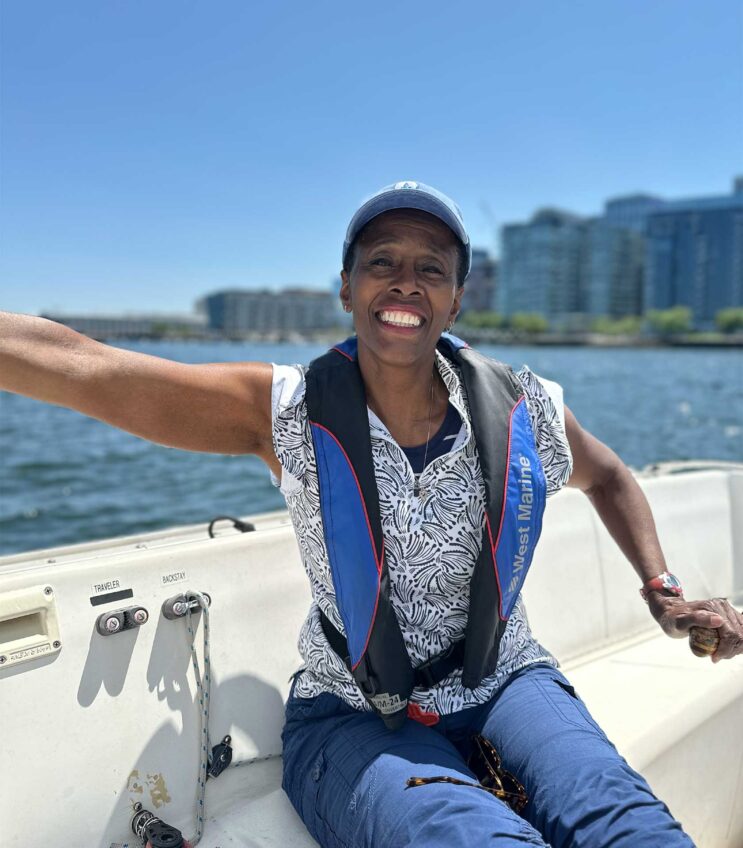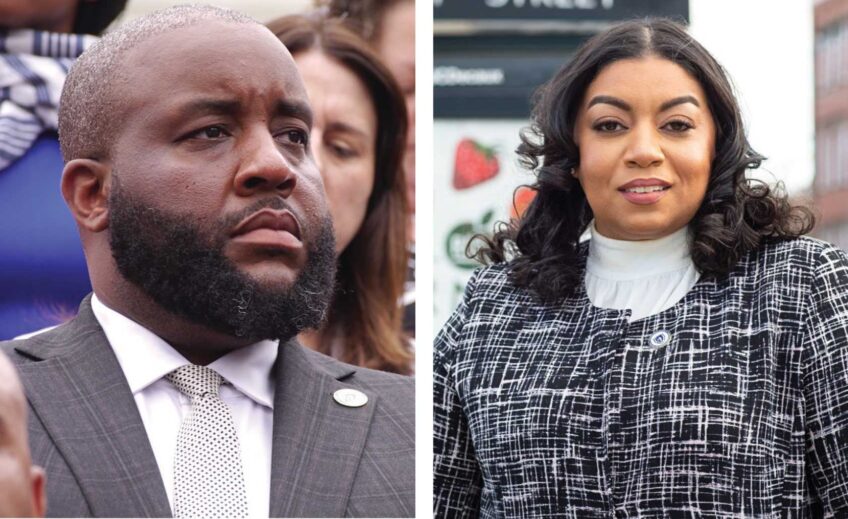World-renowned dancer Judith Jamison and pioneering journalist Maria Hinojosa shared their stories during the recent Simmons Leadership Conference

World-renowned dancer Judith Jamison and pioneering journalist Maria Hinojosa shared their stories during the recent Simmons Leadership Conference
Judith Jamison is retiring this summer after 22 years as artistic director of the Alvin Ailey American Dance Theater. Under her leadership, the group became what many consider the world’s most successful modern-dance troupe.
In 1965 Ailey discovered the Philadelphia born-and-raised dancer and invited her to join his company. After her riveting performance of “Cry,” a solo Ailey created for her, Jamison soared to international fame. She left the Ailey Company in 1980 to dance on Broadway and in 1983 returned to choreograph for Ailey.
Ailey crowned Jamison head of the Alvin Ailey American Dance Theater before his death in 1989.
Born in Mexico City and raised in Chicago, Maria Hinojosa is a pioneer in the journalism arena, illuminating the oft-untold stories of underrepresented and downtrodden people.
Driven in her mission to report the richness of the American experience, the down-to-earth Hinojosa has won two Emmys, an Associated Press Award and the Robert F. Kennedy Journalism Award. She was the first Latina hired by NPR in Washington, spent eight years reporting urban affairs for CNN and now heads her own nonprofit media company, Futuro Media Group.
Both Hinojosa and Jamison took a few minutes to chat wth the Banner before they participated in last month’s Simmons Leadership Conference.
What inspired you to dance and to choreograph?
Jamison: The first performance I had, I was scared to death before the curtain went up. I was in dungarees and pink ballet shoes and a little red checked shirt. It was really corny. The audience applauded and that did it for me.
What inspired me to choreograph was Alvin Ailey. It was 1983. I was just out in the country in Connecticut. Alvin called me and said, “Come on in here and do a workshop with these students.”
The workshop turned into the first piece I ever choreographed.
How did it feel to take over the Alvin Ailey Dance Company in 1989?
Jamison: It felt good. I took over a company when we were in mourning, he had just died. The company was about a million dollars in debt. We buried him and had a performance four days later.
What stands out to you as one of the most challenging moments in your career and how did you overcome that?
Jamison: When Alvin Ailey did “Cry” for me in 1971. The scary part was that I did “Cry” 26 times in a row when it premiered. It was not scheduled. People were calling the box office. I became the first modern dance box office star. The dance is so emotionally and physically hard to do.
And then when I became artistic director it was listening to people. You just don’t dictate to dancers. It’s not a piece of meat over there, that’s a person. They’re giving you everything so you respect and honor that.
What role do black women and other women of color have in dance? What can be done to bring more diversity to dance and ballet in particular?
Jamison: There are places we can go in tutus now because of my teacher Delores Brown who in the fifties didn’t have a place to go. Black women were not touched by white people in New York City when they had partnering classes, they wouldn’t partner them. That brought back too much.
Like what?
Jamison: It brought up all the racism that was going on.
My first ballet teacher Marion Cuyjet was black but looked white as the driven snow. Her skin was white and her eyes were green and she had red hair so when it came to Philadelphia in the fifties she was allowed to rent space down there that black people couldn’t rent and all those little black children would come running after.
She moved seven times because they weren’t having that, and they figured out something that would not violate civil rights. Still to this day there are places where black children can’t study dance.
We always have to find another way, everybody, not just black people. No it’s not easy and you might not find anything right away but don’t shut yourself down.
Now that you’re retiring —
Jamison: Re-wiring — if I I’m retiring I’m going fishing in Florida. I’m still fundraising and teaching. I just took the crown off this head and put it on somebody else. If I’m on this earth for as long as I’m supposed to be I still want to see the Alvin Ailey American Dance Theater soaring.
What stands out to you the most about your career?
Jamison: I can drop a whole ‘lotta things but the beauty of it is that I can look back on it. I have friends that aren’t here that had wonderful careers but I can look back and look forward at the same time.
What was your life like growing up and how has that shaped who you are now?
Hinojosa: I had a lot of doubt — could I do this? I have felt a lot of responsibility to speak for those who don’t have voice. I came from not a poor family, we were incredibly well off, but I did end up going to a very good school and I think that that’s where I understood that I had a role to play. There were many other people who were very disadvantaged who looked like me, sounded like me, had my similar background, but were truly invisible.
How do you feel about the role of people of color in the media?
Hinojosa:It’s a battle right now. I can’t believe that this many years later into my career there’s a lot of resistance. There is much more diversity but the question is whether or not there really is an understanding of the media covering us as a country in terms of understanding our diversity. And I think that in some ways pop culture gets it better than even the news media, and that’s kind of strange and it has been said that the media, the Fourth Estate, is the one that will pose the most resistance to change. Fortune 500 companies will actually understand diversity more so than members of the media, and how could that be?
How do you feel about the Internet growing as the main source of news?
Hinojosa: I’m part of the change and I’m also victimized by the change and growing because of the change. We used to know exactly what journalists did in our country, now when you have the Internet where anybody can say that they are journalists, it really does pose a challenge to us. And the Internet has completely changed the dynamic. In a lot of ways for good because everybody has a voice but in other ways not so
good because you’re not sure who’s giving you the information you’re getting, and so that’s complicated.
Could you recall some challenges you faced and some rewarding moments you had?
Hinojosa: I face a challenge everyday because I am running my own nonprofit media company. I do it because I feel like I have a responsibility. When people meet me and they say thank you for your work, that’s when I’m like “OK, I can’t retire.”
What advice would you give to minorities who want to succeed in media?
Hinojosa: They have got to find their voice, trust that they know what they’re talking about, get trained, work really hard, find their mentors and their elders.






